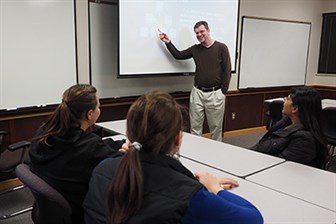 There are many teaching innovations that are being implemented in universities to improve instruction. Many faculty within the Department of Computer Science and Engineering at Texas A&M University are actively bringing these practices to their classrooms. One new method of teaching is called “flipping the classroom”, in which students are asked to review the material before coming to class. Then, the class time is used for interactive activities to clarify or deepen understanding. By doing so, professors are able to engage students in the material and take better advantage of the time allotted in class.
There are many teaching innovations that are being implemented in universities to improve instruction. Many faculty within the Department of Computer Science and Engineering at Texas A&M University are actively bringing these practices to their classrooms. One new method of teaching is called “flipping the classroom”, in which students are asked to review the material before coming to class. Then, the class time is used for interactive activities to clarify or deepen understanding. By doing so, professors are able to engage students in the material and take better advantage of the time allotted in class.
Professor and Graduate Advisor, Dr. Andreas Klappenecker, flipped the course CSCE 411 Design and Analysis of Algorithms in hopes to achieving this end.
“Here, the idea is to provide small videos of lecture materials that the students can watch before class,” Klappenecker said. “This allowed me to give just a brief summary of the material. The time gained is used to let the student actively work on problem solving during class, where they can ask me for help when they are stuck. The result was that students were much more engaged.”
Klappenecker was one of 10 faculty selected to receive the 2014 Association of Former Students (AFS) Distinguished Teaching Achievement Award at the University Level. Along with this honor, he was recognized for his use of new teaching methods, such as flipping the classroom. According to his nomination letter, “The comments [from student feedback] indicate that flipping this class seems to work exceptionally well. Klappenecker noted that the performance of students in the midterm exam improved in comparison to previous versions of the course.”
By giving the students material to work on ahead of time outside of the classroom, they are given the chance to work through what they understand and what they do not. That, in turn, can be discussed in class, which leads to a learning environment that is more in tune to the students’ needs.
“For me the fundamental goal for teaching innovation is encouraging active learning,” said CSE TEES Research Associate Professor and Part-time Senior Lecturer, Dr. Hyunyoung Lee.
Lee achieves this goal by distributing in-class exercises in almost every class, which the students solve together along side her during the lecture. She said she also gives take-home quizzes, so the students can look up the class notes and the textbook in order to answer the questions.
“In the classroom I explain and discuss the class topics in relation to the homework problems, which catch the students' attention because by listening to the discussions, the seemingly difficult homework problems become more manageable," Lee said.
CSE Assistant Professor, Dr. Dylan Shell was awarded with the Montague-Center for Teaching Excellence (CTE), which provides resources and services to faculty in order to amplify teaching and student learning at Texas A&M University. With the awarded funds, he plans to supplement budgets for the CSCE 482 Senior Capstone Design course. Shell’s research interests include Distributed AI, Biologically-inspired multi-robot systems, Coordinated system, Analysis of multi-agent systems and Crowd Modeling.
CSE Raytheon Professor, Dr. Robin Murphy, also received a grant from the Texas A&M CTE to help her to develop the materials to flip her class. She is an IEEE Fellow for Innovation in High-Impact Learning Experiences. These individuals each receive a grant of $3,000 to support a proposed project to develop, implement, and evaluate innovative high-impact learning experiences in one’s teaching program.
While there are many other methods that allow student involvement, this approach is growing in popularity and with good reason as students are excelling in their coursework.